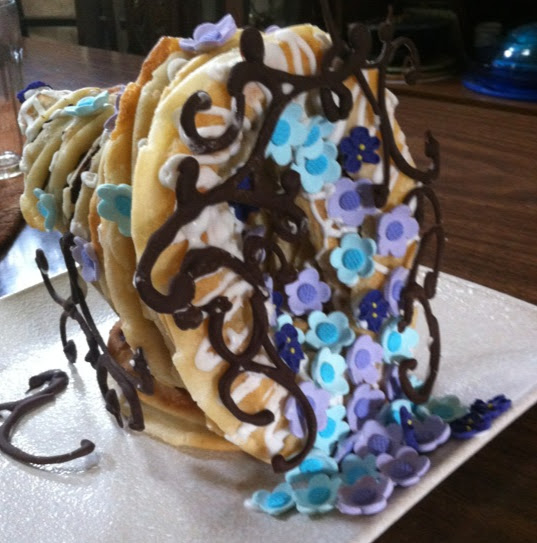 |
| Kransakaka or Overflodigshorn |
You could say that I have control issues. You'd probably be right. I'm am one of life's organisers. I live for detail and the ticking of boxes, the crossing of t's and the dotting of i's. Knowing that all is running smoothly, that the cogs are turning in a well-oiled machine (be it at home or at work) makes me really happy.
Others might say I need to relax more. Whatevs...
I think that's why I really enjoy challenging cooking projects where structure and appearance are as important of the taste of the food. This has been reflected in my gingerbread making and most recently in my buche de noel cake, and here it is rearing its head again in my Scandinivian kransakaka.
The Clandestine Cake Club Perth (run by the two gorgeous gals behind wherethewindblowsme and Carolanne's Kitchen) is fast becoming popular in Perth. The idea is that once every 4 to 6 weeks, you bake a cake according to the theme that the hosts set, front up with your cake, talk about your cake, eat some of everyone else's cake and take boxes of cake home. Win win!
My busy schedule (of which I am completely in control) has meant that I was unable to attend a Cake Club meeting until yesterday when I went for the first time. The theme for this meeting was "Scandinavian and Eastern European Cakes" and when I saw this I knew I could not stay away and that I had a show-stopper of a cake to offer.
*Philological Interlude - feel free to skip*
The kransakaka is a traditional wedding cake from Scandinavia. It is called 'kransakaka' in Sweden and Iceland, 'kransekage' in Denmark and 'kransekake' in Norway. It is a tower of concentric baked marzipan rings decorated with chocolate swirls, candies or toffee. The variant to the kransakaka is the overflodigshorn ( or overflodigshedhorn) when the kransaka is shaped to form a cornucopia or horn of plenty.The idea of abundance is symbolised by candies or little cakes spilling from the mouth of the horn.
I wanted to have an overflodigshorn for my wedding many years ago. It wasn't to be (and I was delighted with the wedding cake that I did get) but I never forgot it. Now, in the time of the Internet and online recipes, I came across this video recipe and decided to give it a go.
It wasn't easy. I halved the quantities of the ingredients to give me a more manageable-sized cake. I think my poor maths abilities resulted in a dough that was a little too soft. As a result, some of the rings didn't hold their shape and the horn was not quite as perkily curved as it was meant to be, but it didn't matter. I got control over that marizpan pastry and shaped it to my will (I feel a sense of megalomania coming on...) It was the work of less than a day, it was a realistic (stumpy) horn, self-supporting on a base, and the decorations looked baroque and beautiful.
One of the most intriguing parts of making the cake was cutting the dough and realising that I was cutting it in a Fibonacci sequence (my maths abilities might be poor but my inner geek is trying hard to compensate). As best demonstrated by the chambered nautilus, the growing spiral is developed by applying Fibonacci numbers to the dough. Professional pastry chefs can actually get their kransakakas curl right over, just like a ram's horn.
Oh, and it tasted amazing! Like a marzipan macaroon, firm on the outside but soft and squishy in the middle. If you love marzipan, you will love this cake.
Then I took the kransakaka to Cake Club where it got to sit on a table which was overflodigs with at least a dozen other cakes and there was abundance indeed.
I've photographed some of the steps below, but for the best results, I recommend that you watch the video that I linked earlier if you too wish to battle marzipan and gravity and be victorious. The end result is completely worth it.
 |
 | ||
| Fibonnaci marzipan dough |
 | ||
| Little 'cigars' |
 | |
| Sitting by the oven, waiting. The dough needs to be just toasted golden. Don't let it burn! |
 |
| The pieces come out of the oven. The small ones have held their shape, The large ones have not. |
 | |
| The iced pieces are stuck together with melted chocolate. The back section needed some support while the chocolate dried. |
 |
| Overflowing with sugar flowers |
 |
| My horn-shape was rather stumpy but still a self-supporting structure! |
 |
| Baroque chocolate swirls feature on traditional kransakakas. |
 |
| In a box, being transported to Cake Club. Longest car journey of my life! |
 | ||
| Finally on the table surrounded by other Scandinavian and Eastern European goodies |



